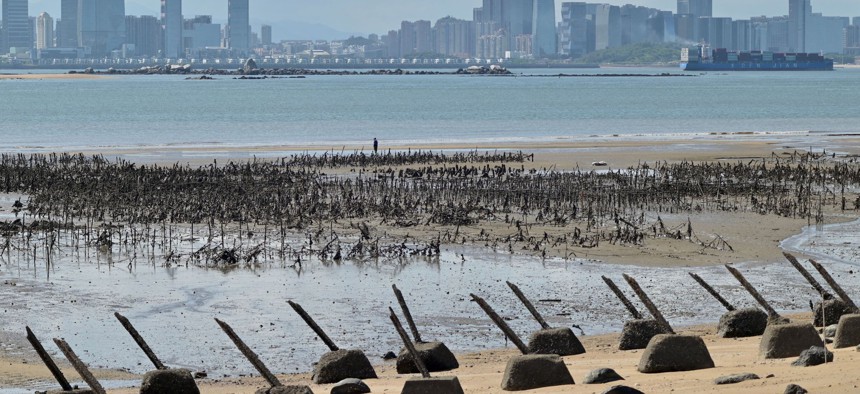
The Xiamen city skyline on the Chinese mainland is seen past anti-landing spikes placed along the coast of Lieyu islet on Taiwan's Kinmen islands, which lie just 3.2 kms (two miles) from the mainland China coast, on August 10, 2022. AFP via Getty Images / Sam Yeh
How Beijing Is Changing Its Rules Around Taiwan
Three lessons from China’s recent exercises around the self-governing island.
China put on an ominous firepower display for the world and Taiwan following House Speaker Nancy Pelosi’s visit. Many have cheered Pelosi’s bravery in visiting the isolated island, just 90 miles off the coast of a rising superpower. But though Pelosi has returned home safely and enjoyed the adulation in the media, the people of Taiwan and in the wider Asia-Pacific region will unfortunately continue to live with a dire security situation made much worse over the last weeks.
There appear to be some changes in China’s military posture toward Taiwan that will leave the beleaguered island more vulnerable. Three aspects of the drills by the People’s Liberation Army, or PLA, are most troubling. First, the exercises involved quite extensive and brazen movements along Taiwan’s relatively sheltered eastern shores, the area through which the U.S. and its allies might hope to resupply and reinforce the island should China invade.
Additionally, these exercises appear to be the end of any dividing line that had previously limited the deployment of Chinese forces near Taiwan. An informal median line has helped maintain peace in the Strait for decades, but Chinese officials have now made it clear that they no longer accept it. Indeed, Beijing has stated recently that Taiwan has no territorial seas; this seemingly new doctrine likely applies to the island’s airspace as well.
A final ominous conclusion from the exercises concerns the types of fires used. Not only did the PLA launch ballistic missiles over Taiwan in a dramatic display of firepower, but there was also a subtle message with the testing of rocket artillery fire into the Taiwan Strait. Rocket artillery is much cheaper and easier to launch than ballistic missiles. Rocket artillery that can reach across the strait would threaten radars, runways, munitions stores, headquarters and other crucial defenses, and could be used to coerce or in preparation for invasion.
While China has nearly all it needs to conduct a swift conquest of Taiwan, there are still vital pieces missing on the naval side, in particular. Thus, it is telling that on Aug. 8, Beijing announced that drills around Taiwan would continue and they would focus on anti-submarine warfare, or ASW. China has made much progress in this field, including deploying corvettes with towed sonar arrays and maritime patrol aircraft. Still, the Chinese fleet remains quite vulnerable, because its ASW helicopters are few and not very capable.
Beijing aims to change that. A recent issue of the Chinese magazine Ordnance Industry Science and Technology profiled the new Z-20F. The article says the new helicopter will quadruple the ASW search range for PLA Navy surface combatants from 50km to 200km. It will carry 20 to 25 sonobuoys, a large surface-search radar, and an “extremely advanced” magnetometer. In addition to “guided depth bombs,” it will be able to carry two of the new Y-11K lightweight torpedoes, which have a sprint speed of 50 knots and a range of 25km. Underscoring the importance of this new platform for the future Chinese Navy, one may note the article explains that the PLA Navy will be looking to acquire more than 200 of these airframes.
Yet, at this point, the Z-20F remains in sea trials, and therefore China’s ASW capability remains in doubt for at least the near future. The PLA Navy intends to employ sea mines and also to rely on the country’s vast Coast Guard to help close this gap, but China will remain at a disadvantage to U.S. and other submarine forces. Other major parts of China’s military arsenal also remain a work in progress, including its nuclear forces, aircraft carriers, and heavy bombers.
In the end, Chinese leaders understand that both sides are making intensive military preparations and that the Chinese military will never be 100 percent ready. Given China’s extremely favorable geography for an attack on Taiwan, Beijing understands that victory over Taiwan is nearly certain, but the costs in blood and treasure could be exceedingly high—up to and including the loss of warships of great symbolic importance like its new aircraft carriers. Unfortunately, Chinese leaders seem to be very willing to pay such immense costs to achieve victory. This point about costs relates to the rather stark asymmetry of interest and national will that makes the Taiwan scenario so precarious for the U.S. and for the wider world. After all, most Americans could not find the beleaguered island on a map.
A realistic U.S. policy for Taiwan should accept the fact that China’s calculus on Taiwan is not strictly rational. No matter how many Javelins, Stingers, Harpoons, Patriots and HIMARS are packed onto the small island, China is not likely to be deterred. Indeed, these weapons shipments could have the opposite effect: of lighting the fuse.
Washington would be wise to draw its red lines for the Asia-Pacific elsewhere and not over Taiwan. American leaders must act with the utmost caution to avoid a catastrophic superpower war over Taiwan that could quite easily slip over the nuclear threshold.
Don't miss: